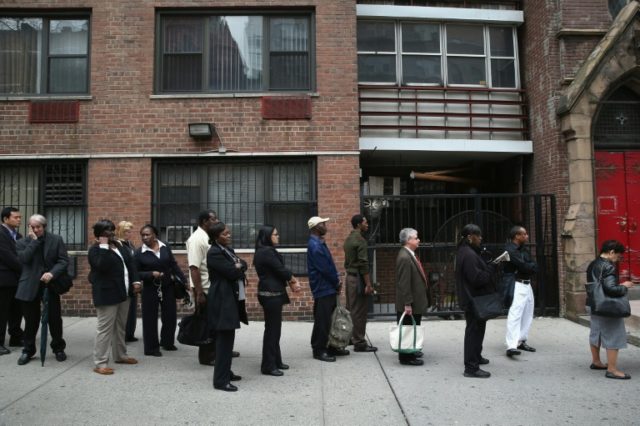Washington (AFP) – The US jobs report on Friday showed the black unemployment rate in April fell to its lowest on record but the figure hides a multitude of racial disparities.
And those disparities reflect the failure to bring able-bodied people into the workforce at a time when many jobs go unfilled.
President Donald Trump has repeatedly crowed about the falling unemployment rate for African-Americans, taking credit for economic policies that have driven strong hiring, and he did so again Friday after the Labor Department released the jobs report.
But the data show the rate, which hit 6.6 percent last month, has been declining steadily since it peaked at nearly 17 percent in March 2010 at the tail end of the Great Recession — compared to a high of nine percent for whites.
However, with employers around the country struggling to find enough skilled workers to fill open positions, while the Trump administration is cracking down on immigration — usually a sure supply of new workers — economists say the country still faces racial barriers to employment and earnings, reflected in the much smaller share of blacks in the labor force compared to whites.
To be counted as part of the labor force for purposes of the Labor Department’s data collection, a person must either be employed or unemployed and have looked for a job in the past four weeks.
The share of people who are unemployed but in the labor force generates the jobless rate and that rate fluctuates either because of an increase in the number of people who find jobs or a drop in the number of people in the labor force.
– Fewer blacks in the workforce –
The overall jobless rate fell below four percent in April for the first time in just over 17 years, but the drop was due mostly to the labor force shrinking, rather than increased hiring.
The participation rate for African-Americans lags that of other racial groups but not by much: just under 62 percent, compared to about 63 percent for whites and Asians. Hispanics, who can come from any racial group, have the highest participation rate at 66.4 percent.
However, that misses the large numbers of blacks excluded from the pool of available workers: the share of blacks in the workforce compared to the total population is under 58 percent, compared to 61 percent for whites and Asians, and over 63 percent for Hispanics.
For prime age workers, 25-54 years old, the differences are even more stark, and prime age black men lag more than 10 points behind men of all other worker groups.
“The unemployment rate for young black men parallels many developing and third world countries,” said Nicole Smith, chief economist at Georgetown University’s Center on Education and the Workforce.
And the rate is “entrenched,” meaning they “aren’t moving, aren’t cyclical in nature, are not influenced by the business cycle.”
The problem is so long-standing that the Federal Reserve — which has achieving “full employment” as one of its two policy goals — has studied the issue extensively and held a conference to on it last year.
One paper by Fed labor economist Tomaz Cajner and others confirms that the disparities cannot be fully explained by documented factors like age and education: in economist-speak the “observables.”
“(T)he remarkably low participation rate of black men is largely unexplained by observables…and has shown little improvement over the last 40 years,” Cajner and his coauthors wrote.
And even amid the economic recovery from the Great Recession “the disparities remain substantial,” the paper said.
– Potential workers in prison –
Smith told AFP educational opportunities are a key factor to explain the differences, but they also reflect entrenched discrimination in a country that has long struggled with its history of racism.
“Those variables are in fact highly correlated with each other. The lack of opportunity in education is highly influenced by race, highly-influenced by socio-economic status, even by your location,” she said. There is “a discrimination component.”
That in turn snowballs into helping determine the chance of getting and holding a job and of keeping it during an economic downturn, as well as workers’ earning potential over a lifetime.
Another factor is the much higher incarceration rate for blacks, which can bar them from the workforce permanently since many employers will not hire, or even consider, anyone with a criminal record.
In 2016, blacks represented 12 percent of the US adult population but 33 percent of the prison population, according to the Pew Research Center. Whites accounted for 64 percent of adults but 30 percent of prisoners, while Hispanics represented 16 percent of the adult population, and just 23 percent of inmates.
Smith said this is significant especially for young black men because “you can never get that off your record.”

COMMENTS
Please let us know if you're having issues with commenting.